|
|
Collections
& Interests
..................................................................................................................................
Collection of Antique Prints and Engravings (16thc – 19th c) Central
Eastern Europe
Habsburg Empire, Russian Empire, Ottoman Empire ( Turkey in Europe)
the Principalities of Transylvania, Moldavia & Wallachia (present-day
Romania
.......................................
The Philosophy of the Collection :
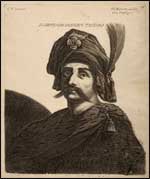 |
| Portrait
of Prince Dimitrie Cantemir by Claude Vignon |
No single person could better represent the philosophy of this Collection
than Prince Dimitrie Cantemir. Born in Moldavia, educated in Istanbul, to
become a true Renaissance figure Cantemir spoke and wrote fluently in several
languages, was ennobled by the Tzar after the battle of the Pruth in 1711
and became a member of the Berlin Academy . Cantemir’s scholarly treatise
on the History of the Ottoman Empire remained for 200 years a crucial reference
book, used by Gibbon, Byron and Shelley and read by Churchill.
Dimitrie’s son, Antiochus, was the first Russian poet and was appointed
the Tzar’s envoy to London, where he translated and printed his father’s
books.
For over 400 years since the conquest of Constantinople, the continuous
wars between the Ottomans and the Habsburgs, followed by the Russian-Ottoman
wars changed the fortunes of empires. Yet in the midst of this maelstrom,
in this Balkan alembic, the cross-fertilization of ideas produced some extraordinary
characters, who led armies, changed borders, encouraged the emancipation
of nations, explored the mosaic of a multi-ethnic society and attracted
the attention of painters and engravers from Western Europe from the earliest
map makers to the classic 18th and 19th century writers and artists.
It is hoped that such multi-faceted aspects, described by Cantemir in his
oeuvre, are reflected in the themes of these engravings, whether depicting
costumes, buildings, scenery, townscapes, battle scenes, military leaders,
or political borders.
This wide-embracing ethos helped coalesce over a period of three decades
the body of this Collection.
 |
| Constantin
Roman |
The Collector :
Constantin Roman is born in Romania and educated in Bucharest and Cambridge.
Since childhood his interest in Arts is stimulated by his maternal grandmother’s
collection of paintings, dispersed under the Communist regime. At the same
time he studied the collection of old engravings and prints of the Biblioteca
Centrala Universitara in Bucharest (formerly Fundatia Regele Carol I) burnt
in December 1989, by the Securitate.
From early childhood Constantin wanted to become an architect, but the positive
discrimination meted out by the Communist regime after the Hungarian revolution
of 1956, caused him to choose instead a career in Science. Ever since he
kept a keen interest in History of Art and Architecture that is reflected
in the current Collection.
Constantin ROMAN qualified with a Masters in Geophysics from the University
of Bucharest. After graduation, he was invited to England, where he applied
for and obtained several scholarships, in the United States, Canada and
England amongst which a Research Scholarship from Peterhouse, Cambridge.
He graduated from Cambridge with a PhD in Plate Tectonics under the late
Professor Sir Edward Bullard, FRS. Roman joined the exploration teams of
major American oil companies in London, at the time of the first discoveries
in the North Sea. He subsequently embarked on a career as an independent
consultant to Industry and Governments, on world-wide projects. www.celticpetroleum.com
This offered him the opportunity to travels and pursue his passion for collecting
items of Romanian interest, which form the present-day collection.
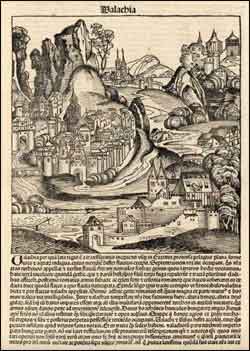 |
| 16C
Italian Woodcut of Wallachia |
After the fall of Ceausescu regime, he returned for a brief spell to the
University of Bucharest as Visiting Professor. In 1997, in recognition of
his contribution to Romanian Seismo-Tectonics Dr Roman was awarded the degree
of Professor Honoris Causa of the University of Bucharest and President
of Romania, Emil Constantinescu (1996-2000) named him a Personal Adviser
(Energy and Natural Resources). In 2000 The Institute of Physics Publishers
(Bristol and Philadelphia) printed “Continental Drift, Colliding Continents,
Converging Cultures” which charts Constantin Roman’s career and
contribution to Earth Sciences as well as his Cultural forays . In 2002
Professor Roman was invested with the Order of Merit (Culture) with the
grade of Commander.
Constantin ROMAN is a British subject and currently lives in London.
History of the Collection:
The Collector bought his first prints whilst a postgraduate student
in Cambridge, in the early 1970's, when very few people were interested
in the subject and prices were accessible. Over the following thirty years,
as a Geophysicist, he had the opportunity to travel extensively and added
substantially to his collection, mostly from dealers in England, France
and Holland. His particular interest concentrated on images from the Ottoman
Empire in Europe, with emphasis on Wallachia and Moldavia (the Lower Danube
and the Carpathians) as well as the Eastern part of the Habsburg Empire,
(the Principality of Transylvania). Auxiliary themes of a wider regional
interest (Polish, Russian, Balkan, Hungarian, Austrian, Turkish) are also
present.
Subject Matter:
The subject of the collection has a strong topographical interest. It consists
of maps (including plans of battles and strategic fortifications), views
(landscapes and townscapes), costumes, portraits of historical characters,
scenes of social and political interest, architectural / natural monuments,
political cartoons of the 19th century, etc. Breakdown of the Collection
in main themes and epoch:
|
16C |
17C |
18C |
19C |
20C |
Unattrib |
Sub
Total |
|
|
|
|
|
|
|
|
VIEWS
|
0 |
13 |
7 |
33 |
0 |
11 |
64 |
COSTUMES
|
0 |
0 |
15 |
35 |
0 |
32 |
82 |
MAPS
|
7 |
16 |
33 |
8 |
0 |
4 |
68 |
MILITARY
|
0 |
4 |
19 |
21 |
0 |
0 |
44 |
CARTOONS
|
0 |
0 |
0 |
23 |
1 |
0 |
24 |
ROYALS
|
0 |
1 |
4 |
15 |
2 |
0 |
22 |
FINANCE
|
0 |
0 |
0 |
0 |
24 |
0 |
24 |
DANUBE
|
0 |
0 |
0 |
13 |
0 |
18 |
31 |
BLACK
SEA
|
0 |
3 |
13 |
11 |
0 |
8 |
35 |
FRAMED
|
0 |
0 |
0 |
0 |
0 |
99 |
99 |
|
|
|
|
|
|
|
|
TOTAL
|
7
|
37
|
91
|
168
|
27
|
176
|
506
|
|
|
|
|
|
|
|
|
Comments:
Rare Items, Oddities and Famous Artists
- 18th
c manuscript field map of Eugene of Savoya (Habsburg-Ottoman) battle
- Engravings
by the great Romanian painter Theodore Aman
- Sketch
of historic Downtown Bucharest
- Drawings
for the test exams at the school of Architecture, Bucharest
- Political
cartoons of the Russian-Turkish wars by Daumier, Cham,
W. Heath
- Plans
of 17th and 18th century battles of Habsburg-Ottoman and Ottoman-Russian
military engagements and plans of fortifications
- Portraits
of Princes Dimitrie Cantemir, Antiochus Cantemir, Eugene of Savoya and
Brancovan
- French
Cartoon of Countess Anna de Noailles (nee Princess Brancovan) and Gabriel
D’Annunzio
- 3D perspective
map of the Black sea (19th c)
- 17th
and 18th centuries Russian, Hungarian and Swedish and Dutch prints
- Share
certificates of Romanian oil fields (and of Caucasus)
- 18th
c military uniforms of Romanian regiments in the Habsburg Army
- 19th
c Greek Independence battle of the Etheria fighters against the Turks
- Hungarians
at Ovid’s tomb (1791)
- Some
Artists - Daumier, Raffet, Bouquet, Lancelot, Preziosi, Turner, Theodore
Aman, Claude Vignon, Pierre Francois Basa, Emile-Louis Vernier, Auguste
Alexandre Hirsch, WH Bartlett, Valerio, P.F. Tardieu, Schlotterbeck,
Cham, William Heath, F. Sorrieu,
- Some
Map Makers - Homann, Ortelius, Mercator, De Fer, Ruscelli, Merian, Munster,
Lotter, Moll, Hondius, Probst, Valk, Schenk, Castaldo, sanson, Stackhouse,
Winter, La Feuille.
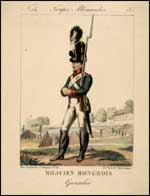 |
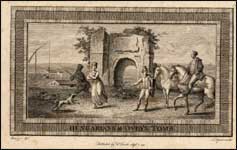 |
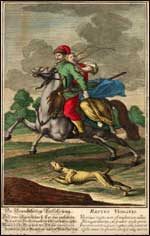 |
| Austrian
Military Dress |
Hungarians
at Ovid's Tomb |
"Raptus
Virgiinus" |
UNATTRIBUTTED
ITEMS: other than the 99 framed pictures discussed above, once they would
get a specific date will give a more accurate idea about the exact age
structure of the collection, perhaps with a greater weight on the 18th
century.
About half of the unattributed items represent the 99 framed
pictures which are mosttly 19th century views of the Danube, Bucharest
and the provinces as well as many costumes. There are some 18th century
military uniforms of Romanian regiments in the Austrian army and a few
maps. Most of the framed prints are French, English and German with some
Hungarian and Austrian engravings and a few drawings and sketches.
There is a certain overlap amongst the themes. For example:
- The BLACK
SEA will include maps as well as views of ports
- The CARTOONS
will have military themes and Royalty
- The COSTUMES
will include some 18th c Royals
- The DANUBE
will have views of ports as well as Military fortifications and some
battles
- The FINANCE
will have share certificates of oil companies with pictures of oil fields,
and costumes and the bank notes the head of king Carol II
- The MAPS
will have extensive coverage of the Danube and the Black Sea as well
as plans od Military
fortifications.
- The MILITARY
will have coverage of Royalty and plans of battles along the Danube
- The ROYALS
will have some views of events attended by Royalty in Bucharest and
elsewhere
- The VIEWS
would have some scenes of the Danube, of Bucharest and of costumes
- The FRAMED
PICTURES would have only a few maps and Military costumes with a
majority of views of the Danube, and Bucharest and especially costumes
and views of architectural monuments
- DUPLICATES:
There would be some framed pictures of views and costumes which are
also in the files of unframed engravings – probably no more than
3% of the total items. However amongst the few maps which appear to
be duplicates they may have a different original hand colour applied
 |
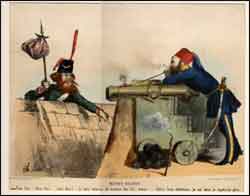 |
| "HORA"
the wallachian village dance, after a painting by Theodore Aman |
19C
French Cartoon of the
Russian-Ottoman War |
Structure
of the Collection:
The collection of just over 500 items encompasses a variety of woodcuts,
steel/copper engravings, mezzotints, lithographs, and some RARE ITEMS
such as original manuscrpt maps, drawings and artist’s editions .
Perhaps the most interesting item represents the framed 18th century manuscript
map on Parchment of the battle between the Austrian Armies under the command
of General prince Eugene of Savoya and the Ottoman armies in the 18th
century, on the Danube valley, near Timisoara. Equally important are the
Paris engravings of the great classic Romanian artist Theodore Aman, whose
paintings are found in the National Museum in Bucharest and in the Aman
memorial House.
Ninety-Nine items are framed, whilst the remainder of some 400 engravings
are mounted on non-acid cardboard and protected by a transparent
non-acid overlay. Presently there is an preliminary catalogue, in
first draft which needs to be completed with regards to the exact date
and source attribution, artist biographies and full descriptive of each
print. .
Presently there is a preliminary catalogue, which needs to be further
refined with regards to the exact date and source attribution, artist
biographies and full descriptive of each print. Artists and Sources:
Artists and Sources:
Prior to the 19th century these provinces of the Austrian and Turkish
Empires were not on the Grand Tour and due to the ongoing wars they did
not attract the interest of major artists who would produce engravings
of views and costumes. There were of course exceptions - the occasional
travellers to Istanbul crossing Wallachia in the 17th and 18th centuries,
but they were not accompanied by artists to make a sketch of the lands
they crossed (Lady
Mary Wortley Montague). From a political point of view, however the area
was surveyed by all major European cartographers. The constant change
in frontiers between the Turkish, Austrian, Prussian and Russian empires
is reflected in this very area of our collection. As such the prints have
a wealth of information on the Austrian Turkish battles of the 17th and
18th centuries (i.e. Prince Eugene of Savoya’s) or the Russian-Turkish
battles of the 18th and 19th centuries. There are, nevertheless, a few
notable artists prior to the 19th century (Haugenberg, Redinger), who
depicted Romanian scenes such as cities, battle scenes or horses.
In the wake of major European conflagrations (i.e. Crimean War of 1856,
the Russian-Turkish war of 1877, even the Greek war of Independence),
scores of artists were expedited to the Romanian Principalities to gather
intelligence. Their work enables us today to enjoy some wonderful examples
of engravings. Daumier, Raffet, Bouquet, Lancelot, Preziosi, Turner and
the Romanian Theodore Aman produced rich series of plates on this subject.
The Illustrated London News magazine and the French L'Illustration also
often covered either political or travel stories which contained engravings.
The Crimean War of 1856 and the Russian-Turkish war of 1877 had graphic
coverage in the 19th century European press, either with battle scenes
or political cartoons (Daumier), of which the Collection has many good
examples.
Interest of the Collection: TRANS-DISCIPLINARY
(History of Art, Architecture, Geography, Ethnography, Cultural Studies,
History of Russian, Turkish and Habsburg Empires, Military History)
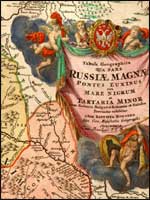 |
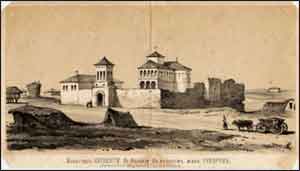 |
The
cartouche of a large
18C Russian map in the collection |
A
Russian engraving showing the HQ of Prince Souvoroff, at the Negoeshti
Monastery during his Wallachian Campaign |
The Deputy keeper of the Prints Collection of a major Museum in London
had inspected this collection in the Spring of 1994 and registered an
interest in it. A second visit by two curators of the same Museum followed
in 2001, on which occasion they acknowledged both the intrinsic artistic
and academic value as well as the cohesive character and effort put into
it, over a period of three decades.
From a prima facie evidence it seems that this collection is not matched
by similar efforts in the public domain, either in Romania, or elsewhere.
The late Professor's Oprescu's collection given to the Romanian Academy
Prints Department has some beautiful examples of watercolours and sketches,
some by Count Prezziosi, but does not overlap with our prints. Prince
Nicholas of Romania's collection of maps has been dispersed soon after
the Second World War. The Victoria and Albert's Museum in London, also
has not got this material although it covers immediately adjacent areas,
such as the Levant and the Middle East, through the recent acquisition
of a collection from a retired Shell executive. .
For
more information and access to pictures of the ENTIRE collection, please
contact me via email.
|